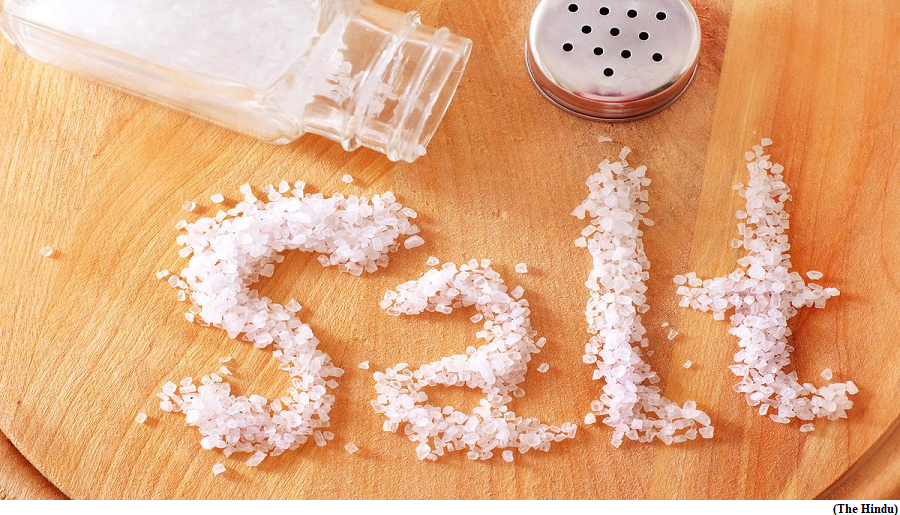Indians eat more salt than WHO recommendation (GS Paper 2, Health)

Why in news?
- The estimated mean daily salt intake in India stands at 8 g (8.9 g a day for men and 7.1 g a day for women) against the World Health Organization (WHO) recommendation of up to 5 g daily, according to a recent survey by the Indian Council of Medical Research (ICMR).
Details:
- The salt intake was significantly higher among men, those in rural areas and overweight and obese respondents.
- The study, carried out as part of the National Non-communicable Disease Monitoring Survey in India, noted that the sample population had a low perception of the harmful effects of high salt intake and practices to limit consumption.
Key Highlights:
- The salt intake was higher in employed people (8.6 g) and tobacco users (8.3 g) and those with high blood pressure (8.5 g).
- It specifies that reducing the intake is a beneficial and cost-effective way to bring down elevated blood pressure by 25% and advocates a 30% reduction in mean population salt intake by 2025.
- It found that less than half of the participants practised measures to control dietary salt intake and the most commonly adopted step to prevent salt overdose was avoiding meals outside home.
Cardiovascular disease:
- Cardiovascular diseases account for an estimated 28.1% of the total deaths in India. In 2016, 1.63 million deaths were attributable to hypertension as against 0.78 million deaths in 1990, the study said.
Dietary sodium intake:
- The study was conducted in a nationally representative sample wherein dietary sodium intake was estimated from spot urine samples, a validated method used to assess dietary sodium intake.
- The population mean was calculated using sampling weights; thus, the study findings could be generalised at a population level and used to plan and implement dietary salt control measures.
India eyes carbon trading, emission reduction targets for 4 key sectors, Report
(GS Paper 3, Environment)
Why in news?
- In a significant move towards achieving its climate goals, India is looking to establish carbon emission reduction targets for four key sectors heavily dependent on fossil fuels.
- The sectors include petrochemicals, iron and steel, cement, and pulp and paper.

Aim:
- This initiative aims to align the country's industrial sector with its broader greenhouse emissions reduction target.
Key Highlights:
- The government will establish carbon emission intensity benchmarks and reduction targets for these sectors over the next three years.
- The market trading cycle will be annual, allowing companies to buy and sell carbon credits to meet their respective goals.
- Companies that exceed their targets will earn carbon credits, which can then be sold to firms falling short of their goals.
- The mandates will be applicable from 2024-25, and the carbon trade will commence in 2025-26. These targets will align with the country's emission intensity reduction goals submitted to the United Nations.
Indian carbon market:
- India has committed to reducing its ratio of greenhouse emissions to gross domestic product by 2030 to 45% of its 2005 level and achieving net zero emissions by 2070.
- The carbon credits will be traded on the proposed carbon market, a provision provided under legislation cleared by the Indian Parliament in December 2022.
- The proposed Indian carbon market differs from those in developed countries, which set an emissions limit and allocate tradable permits or credits to emitter industries.
- In contrast, a committee comprising key ministries such as environment, power, and renewable energy is setting the targets for reducing each sector's emissions in India.
Way Forward:
- The rules and targets for the industries are expected to be announced before December. India already has a market for trading certificates in above-target energy savings for entities in 13 sectors.
- In October, green energy companies, including Adani Green, Hero Future Energies, Ayana Renewable Power, and global private equity major KKR's Virescent Infra, formed a group to mediate between the government and industry.



